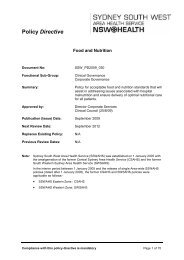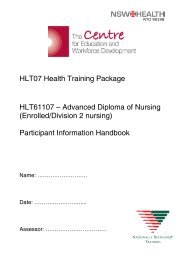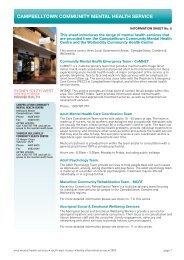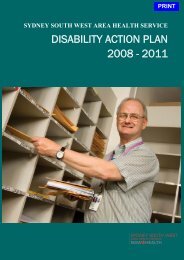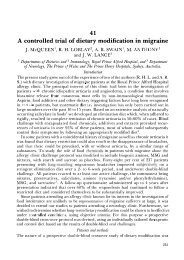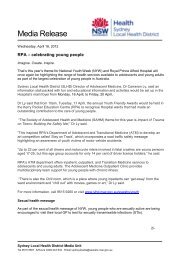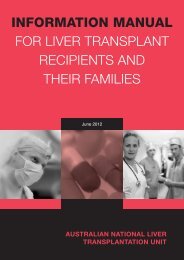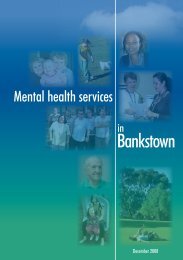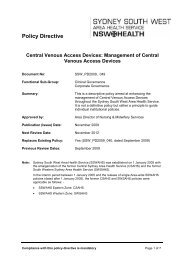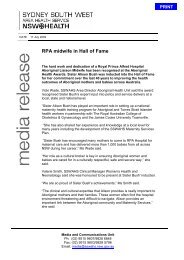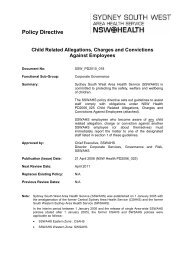Aged Care & Rehabilitation Clinical Services Plan 2007 – 2012
Aged Care & Rehabilitation Clinical Services Plan 2007 – 2012
Aged Care & Rehabilitation Clinical Services Plan 2007 – 2012
Create successful ePaper yourself
Turn your PDF publications into a flip-book with our unique Google optimized e-Paper software.
<strong>Aged</strong> <strong>Care</strong> & <strong>Rehabilitation</strong> <strong>Clinical</strong> Service <strong>Plan</strong> <strong>2007</strong> - <strong>2012</strong>Future Model of <strong>Care</strong>Research is necessary to determine whether or not a “facility based” service is required in the southwest, complementing a smaller number of community packages than the 56 which is currentlyplanned. The Australian Government funded Pathways Home Research Project will inform thisdecision by mid 2008.Recommendation – Transitional <strong>Aged</strong> <strong>Care</strong> ProgramMonitor Transitional <strong>Aged</strong> <strong>Care</strong> Program activity to determine the most appropriate client mixand service structures for ongoing program management6.1.9 Community Dementia TeamsCommunity Dementia Teams (CDT) are a service not yet established in SSWAHS, although theservice is successfully operating in South Eastern Illawarra and Hunter New England Area Health<strong>Services</strong>. The teams generally comprise registered nurses and clinical psychologists.These teams can provide specialist support in community and residential settings, including thecommunity/acute interface, to support people with dementia and their carers. The focus of CDTs isin providing assistance to manage the behavioural and psychological symptoms of dementia. Thereis strong evidence that early intervention/appropriate assessment and planning, around the time ofdiagnosis or onset of severe behavioural disturbance, can prevent escalation of behaviour problems,reduce carer stress, and reduce inappropriate admissions to either hospital or a residential agedcare facility (Brodaty, Draper & Low, 2003). At present, SSWAHS has a limited capacity to respondto this area of need, beyond the initial assessment phase.The service model does not involve long term case management, but rather assessment, initial casecoordination, development of behaviour management and modification strategies, referral for longterm services, and carer education and support. The service should be developed jointly between<strong>Aged</strong> <strong>Care</strong> and Mental Health, with staff ideally located within each ACAT and linking closely withthe Specialist Mental Health Service for Older People (SMHSOP), including the BASIS teams.Funding for a Community Dementia <strong>Clinical</strong> Nurse Consultant (CNC) for SSWAHS was announcedin early <strong>2007</strong>. This position may focus on development of Community Dementia Teams.The HACC program is a possible source of funding for the development of Community DementiaTeams. To date, DADHC has not funded such a service in SSWAHS, despite SSWAHS identifyingthis as a priority for new funding.Recommendation – Community Dementia TeamsPilot two Community Dementia Teams in SSWAHS (at Concord and Liverpool) staffed byRegistered Nurses and <strong>Clinical</strong> Psychologists, linked with ACAT and the Specialist MentalHealth Service for Older People.6.1.10 Centre Based Day <strong>Care</strong>Centre Based Day <strong>Care</strong> (CBDC) provides socialisation and monitoring opportunities for frail olderpeople and respite for carers.SSWAHS operates 20 dementia specific, frail aged, multicultural, ethno-specific and AboriginalCBDC services, funded by SSWAHS, the HACC Program, and the National Respite for <strong>Care</strong>rsProgram (NRCP), or a combination of programs. Each service uses a slightly different model tomeet local needs and funding requirements. There are different opening hours, days of operation,activities and staffing. All provide transport to and from the service, greatly facilitating access. CBDCprograms operate from a variety of venues such as stand alone buildings on hospital sites,Community Health Centres, and Council premises. Some services share facilities to createeconomies of scale.2005/06 ActivityCBDC data is collected and reported differently across the Area due to the variability in fundingsources. As such, it is not possible to compare this data.Page 46




